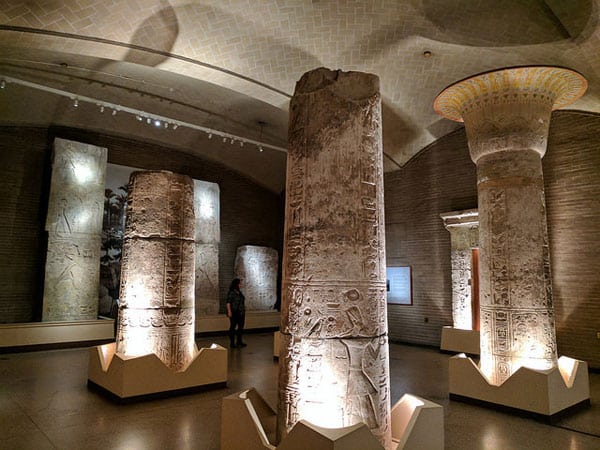
September 6, 2018; Knowledge@Wharton
NPQ has frequently reported on the many ways museums are reimagining visitor engagement strategies using interactive technologies. Examples include the Cooper Hewitt Smithsonian Design Museum in New York City, Amsterdam’s Rijksmuseum, and the Brooklyn Museum. An interview with Julian Siggers, museum director at the University of Pennsylvania Museum of Archaeology and Anthropology—a.k.a. the Penn Museum—offers insights into the thinking behind these strategies and explains how a $100 million planned transformation of 44,000 square feet of galleries aims to incorporate new technologies without overshadowing the objects in the collection.
Siggers notes that in the past, the museum didn’t allow visitors to photograph objects in the galleries and actually charged for the use of archived images from the collection. Now, visitors are welcome to take photographs, and the museum’s website leader, Mike Condiff, who has advocated for a “more is more strategy,” keeps adding new material that can be accessed and downloaded by visitors, or by those who only ever visit the museum virtually.
The evolution within the industry, Siggers explains, is an acknowledgement that every visitor is a “potential advocate who can post your material on social media, download images from your website and use them in ways that you haven’t even figured out. It is wonderful marketing—and free marketing—for museums, to get our message out.”
The Penn Museum owns about a million objects, only some of which are displayed. The collection, as Siggers notes, spans “the whole [of] past human story, from 2 million years ago, from the beginnings of the evolution of our species.” In addition to the academic importance of the collection to scholars at Penn and around the world, these ancient objects help illustrate “the relevance of the past to the present” and “how so much…is relevant to us today as city dwellers.”
While technology helps make those connections, the Penn Museum emphasizes the use of digital strategies to enhance storytelling and personal insights, not just add bells and whistles to the visitor experience. For example, visitors can use technology in the galleries to learn about the work of the museum’s field archeologists, to gain insights into the ongoing research behind the collection, and to better understand that discoveries are still being made all the time that shed new light on the ancient world.
Sign up for our free newsletters
Subscribe to NPQ's newsletters to have our top stories delivered directly to your inbox.
By signing up, you agree to our privacy policy and terms of use, and to receive messages from NPQ and our partners.
Siggers observes that another important shift in the museum world is an understanding that for today’s museum-goers—especially younger ones—institutions like the Penn Museum “are not automatically considered to be a voice of authority.” Technology, including access to online images and materials that provide context, is a kind of negotiation with visitors, an invitation to explore what is known and question what is not yet fully understood. As Siggers explains,
The key thing to remember is you just can’t program for an audience without their involvement. What museums are doing increasingly is being more aware of the communities that they want to serve. That means, often, partnerships with those communities where they become part of the programming process. You are essentially asking them what they would like. We are about to open a series of galleries that highlight our African collection, and we have set up a steering committee of community members to get at what issues they would like to explore in a gallery with content like that.
For a leading educational institution like the University of Pennsylvania, digital technologies also multiply the impact of teaching and research about the museum’s collection. Again, from Siggers:
We have these million objects, and most of them aren’t on display. But now we have digitized around 700,000 of those, and we also put all of our content, our lectures on our YouTube channel. It’s amazing. We can have a lecture in one of our lecture halls on something that is reasonably esoteric like early cities of Mesopotamia [and make it accessible to a global audience]. We found that within a year that lecture had 30,000 views from all over the world. We were contacted by people from Australia who are using our content in their classrooms as well as for their own personal edification.
While one could argue that making so much of the museum’s collection and materials available online for free might cut down on actual visitors, the Penn Museum does not seem to see that as a concern. Siggers says that the museum currently has about 200,000 visitors a year, and with all the gallery transformations and other investments being made—including new digital technologies—he fully expects that number to double. He notes, “Right now, anybody who is an archaeologist or art historian, who deals with the ancient world, knows about our museum. [As] these galleries reopen…my gauge of success will become more public-facing. I would like any visitor to Philadelphia to be very upset if they don’t have an opportunity to come to the Penn Museum. It has to be an absolute must-see when visiting Philadelphia.”
It is worth noting that digital technologies in the world of museum-visitor dynamics seem to be working in both directions. Just last week, NPQ reported on a grassroots effort that created a virtual museum, the Houston Flood Museum, to gather stories and share collective learnings based on the impact of Hurricane Harvey in 2017. And in the wake of the devastating fire last week at the National Museum of Brazil, students at UNIRIO, the Federal University of the State of Rio de Janeiro, are doing their best to create a virtual archive of the objects that were lost, as reported by Atlas Obscura.—Eileen Cunniffe













